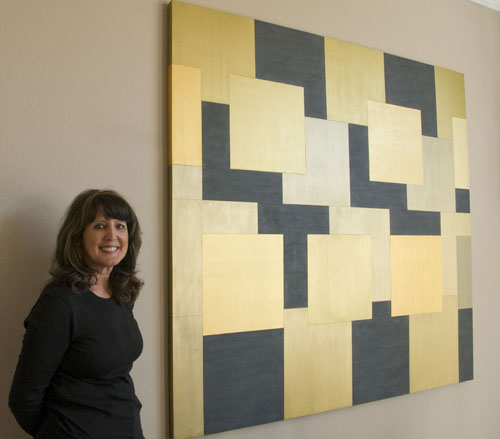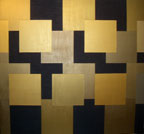Wealth & Benefits
“Beautiful Art Beautiful Artist”
Jeanne Willette, Art Historians of Southern California, July 6, 2012
|
Jeanne S. M. Willette, July 6, 2012 |
|
|
Now she has left behind that labor-intensive mode of painting in oil in high-melt wax behind in favor of a visual contest with acrylic vying with oil paint. Water-based acrylic paint is lean and matte in finish, while oil paint is fat and shiny and juicy. The result is—back to art history—a perceptual “push-pull” effect, like Hans Hofmann. But Hoffman used color, setting advancing color against receding color and causing visual vibrations. But Kerwin tends to keep her colors close. The range of contrasts within in each work tends to be very narrow, and the surface action is kept at a subtle level with a restrained application. The possible pop of color is kept trapped within a confining cage of shapes. While Joseph Albers set square within square in order to pay homage to all the possible permutation of color relationships, Kerwin is less pedagogical and more playful. As a result her “squares” are not sequential but interlocking and interfacing, nestling sharply one against another—fat and thin, pushing for dominance. It takes an exceptionally intelligent painter to keep her many admirers enthralled year after year. | |
“Barbara Kerwin: Geometric Progressions”
Constance Moffatt, 2012
 Barbara Kerwin, Time Zone 2011
Barbara Kerwin, Time Zone 2011
“Line is made by way of a point. Surface is made by way of line…the point in time is to be furnished at its instant and line has similarity to the length of time.”
— Leonardo da Vinci
The survey of Barbara Kerwin’s work presented at Pierce College highlights the journey the artist has made through time. From crafting bird nests as a child growing up in the wilderness of Washington state to creating graceful studies in geometry, making art has never ceased to delight artist Barbara Kerwin. Fueling her curiosity and engendering a natural, meditative state this creating frees her feelings and allows her spirit to flow onto the oceanic canvas. The meticulous use of wax or acrylic produces a calm oasis for viewers within the rigidity of rectangles. Her process is lengthy and sometimes strenuous, yet there seems to be no turmoil in the works. I once told her that there is no conflict in the pieces. Her reply was that it comes before. Those thoughts to turn into rhythmic subtle shades and luxuriant golds stretched across a gridded singing sheet, perfectly in order once again.
The wax pieces compel one to touch them. Critic Mat Gleason said that she is the “manufacturer of the most sensuous, skin-like abstract paintings in Los Angeles.” Her new geometrics using metallics vibrate with the scent of the elusive, ephemeral moment, like a thought caught midway. We wonder what is next in the turn of the rectangle; will it shift forward or back? Cézanne wanted his vibrations of color to be weighty, have more meaning than the works of the Impressionists. Likewise, Kerwin’s pieces are no mere geometries; their rigid shapes get to the heart of nature’s rhythms, to the very structure of what is “forever in the mind.”
Constance Moffatt


